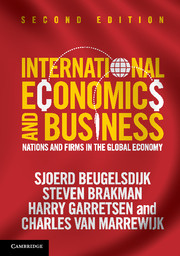Book contents
- Frontmatter
- Contents
- List of figures
- List of tables
- List of boxes
- Preface
- Part I Introduction
- Part II Firms, trade, and location
- 3 Trade, comparative advantage, and competition
- 4 Modern trade theory: the role of the firm
- 5 Trade restrictions and trade policy
- 6 Firms, location, and distance
- 7 Managing across borders
- Part III Capital, currency, and crises
- Part IV Consequences of globalization
- Bibliography
- Author index
- Subject index
3 - Trade, comparative advantage, and competition
from Part II - Firms, trade, and location
- Frontmatter
- Contents
- List of figures
- List of tables
- List of boxes
- Preface
- Part I Introduction
- Part II Firms, trade, and location
- 3 Trade, comparative advantage, and competition
- 4 Modern trade theory: the role of the firm
- 5 Trade restrictions and trade policy
- 6 Firms, location, and distance
- 7 Managing across borders
- Part III Capital, currency, and crises
- Part IV Consequences of globalization
- Bibliography
- Author index
- Subject index
Summary
Keywords
Comparative advantage • Competitive advantage • Productivity differences • Price equalization • Heckscher–Ohlin–Samuelson model • Lerner diagram • Technology differences • Outsourcing/fragmentation • Tests of trade theories
Introduction
We now turn to the most salient and visible aspect of international interaction: international trade of commodities and services. International trade increases the degrees of freedom for an economy. Without trade, all domestic consumption must be supplied by domestic producers. Trade allows consumers to buy from foreign sources and also enables them to compare prices internationally, instead of only domestically. This increases the arbitrage possibilities for consumers, and as such raises welfare. For firms, being exposed to international trade implies, on the one hand, that they are exposed to more competitors (foreign as well as domestic, where the former might be able to produce at lower costs). On the other hand, global markets increase the potential (export) market for domestic firms (which could have a competitive edge over foreign competitors in certain markets). Additional options arise if firms choose to relocate to foreign markets in order to increase their competitive position by avoiding trade barriers and transportation costs, or by benefiting from local resources.
Trade thus creates both threats and opportunities for all firms. To analyse these, we investigate whether trade patterns are systematically related to certain country-specific characteristics. Can we say anything specific about trading patterns between countries? The answer is yes. We start with the most famous part of the answer, by introducing the concept of comparative advantage. Countries are often said to benefit from competitive advantages, or to suffer from a lack of them. We also briefly discuss the notion of competitive advantage in relation to comparative advantage.
- Type
- Chapter
- Information
- International Economics and BusinessNations and Firms in the Global Economy, pp. 81 - 104Publisher: Cambridge University PressPrint publication year: 2013

